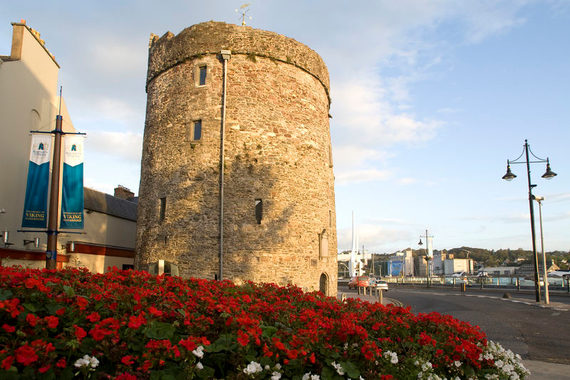As well as its fascinating Viking history, County Waterford has plenty of places to explore.
The popular perception of Vikings is tinged with terror. The Irish tend to think of them as ferocious marauders who pillaged monasteries a millennium ago. But there was more to the Vikings than most people realize and their contribution to Irish society has long been under-appreciated. This is certainly true in Waterford, Ireland’s oldest city (founded by the Vikings in 914), which is celebrating its 1,109th anniversary this year.
Eamonn McEneaney, Director of Waterford Treasures, three historical sites at the heart of the city that house historic and archeological artifacts, said in 2014 that Waterford is unique because it has retained its norse name Vadrarfjordr, which eventually became Waterford.
Vadrarfjordr is believed to derive from either Fjord of the Rams, in reference to the export of sheep from the area, or Windy Fjord. It’s easy to imagine Waterford being a safe haven for Viking ships sheltering from rough Irish seas.
The shelter wasn’t the only thing that attracted them to Waterford. The strategic and trading importance of the three sisters rivers, the Nore, the Barrow, and the Suir, that empty into Waterford Harbor also played their part in the Vikings’ decision to build a longphort (or dock) at the confluence of St. John’s River (another small river) and the River Suir. This marked the birth of Ireland’s first city.
An aerial view of Waterford city.
By 1080, the Waterford Vikings were entangled in the intrigue of Irish politics. The King of Munster Diarmuid O’Brien enlisted their help in sending a fleet to Wales to help a dispossessed king there to recover his lands. (A century later, it was a dispossessed Irish king named Dermot McMurrough who called on help from overseas. He brought Anglo-Norman mercenaries to Wexford in 1169 and, after a siege led by Strongbow, Waterford fell to them in 1170.)
Reginald’s Tower was the first defensive structure built by the Viking settlers. Mentioned in the Irish annals as early as 1088, it’s the oldest civic building in Ireland. It’s been used as a mint, a prison, and a military store, but is now one of the Waterford Treasures, exhibiting artifacts that tell the story of Waterford’s Viking heritage. Waterford was Ireland’s second-largest city (after Dublin, which was also ruled by the Norse) throughout the medieval period. In the 15th century, it repelled two pretenders to the English throne and as a result, Henry VII gave the city its motto – Urbs Intacta Manet Waterfordia or “Waterford, the loyal city.”
More turbulent times followed the Protestant Reformation when the British monarchy severed its links with Rome. Waterford remained Catholic and even participated in the Confederation of Kilkenny – an independent Catholic government, which lasted from 1642 to 1649.

Are you planning a vacation in Ireland? Looking for advice or want to share some great memories? Join our Irish travel Facebook group.
However, the city could not placate both the monarchy and papacy forever. Oliver Cromwell besieged the city in 1649, but it held out against him. In 1650, his son-in-law Henry Ireton succeeded where he had not, and Waterford fell. Many Catholic merchants were expelled from the city and fled to France and Spain where some established themselves in the wine business. The Medieval Museum, another of the Waterford Treasures, houses artifacts from this time. The building itself consists of a 13th-century chorister’s hall and a 15th-century mayor’s wine vault. Its exhibits include a bow from the Anglo-Norman siege of the city and the largest collection of royal charters surviving in Ireland.
The 18th century saw an upturn in prosperity for Waterford. The rise of its great industries of shipbuilding and glass-making date from this time. By the mid-19th century, Waterford had four shipbuilding yards and the first steamship ever to sail into a Russian port was built here. It carried a gift of Waterford glass which was presented to the Tsar in St. Petersburg. Vikings aside, it is this glass that has spread Waterford’s name worldwide. Waterford Crystal was founded by brothers William and George Penrose in 1783. “They were important developers and principal exporters in the city,” says David McCoy, the Sales and Marketing Director with the House of Waterford Crystal. “Their vision was to create the finest quality crystal for drinking vessels and objects of beauty for the home. More than two hundred years later, the reputation they established for creating glass of unsurpassed beauty and quality has transcended the centuries.”

Reginald’s Tower, Waterford City.
Waterford Crystal moved most of its production to Europe in 2009, but the brand still maintains a link with the city. The Bishop’s Palace (another of the Waterford Treasures) displays the largest collection of historic Waterford glass in the world. And in the House of Waterford Crystal, which opened in 2010, more than 600,000 people have seen how glass is still being made in the city.
“Visitors experience a living and breathing crystal factory tour,” says David McCoy. “People can go behind the scenes and witness every stage of production, from the initial design stage and blowing right up to the final engraving of the piece. On completion of the tour, they then experience over 12,000 square feet of crystal heaven in the opulent retail store, which houses the largest retail showcase of Waterford Crystal in the world.”
Fervent republicans may have other associations with Waterford. For it was in this city that Thomas Meagher, the leader of the Young Irelanders in the rebellion of 1848, first unveiled the Irish Tricolor in March of that year, marking a definitive moment in Irish history. At the beginning of the American Civil War, Meagher enlisted in the U.S. Army and rose to the rank of brigadier general. He went on to create and lead the Irish Brigade, one of the most famous units in the Union Army and later was appointed governor of Montana.
Visitors to the city will be able to see the newly transformed historic city center, rechristened the Viking Triangle. Named for its shape, the originally walled part of the city comes to an apex at Reginald’s Tower and still maintains some of its medieval streets and architecture. The Viking Triangle is now home to the Waterford Treasure Museums, which include the Bishop’s Palace, Reginald’s Tower, and the Medieval Museum. The Waterford Crystal Centre is also located there.
Waterford’s history is that of a Viking settlement that grew to become the first city in Ireland. Its people continue to live in the shadow of its ancient walls today. They still benefit from one of the premier ports in the country and some practice trades, such as glassmaking, have been perfected here over the centuries.
Outside of Waterford City
Waterford is an exciting city with a long and vibrant historical story. But its surrounding county has just as many attractions to offer the curious visitor. Towns and villages of distinctive character, an unspoiled coastline, rivers, mountains, places of great history, and lots of unexpected surprises; you’ll find them all if you take the time to explore Waterford.
You’ll find one of Ireland’s best-loved beach resorts, just a 20-minute drive from Waterford City. Tramore (Trá Mór or big beach in Irish) has long offered the traditional seaside experience of ice cream, fairground rides, and sand. The three-mile stretch of beach has its own promenade and amusement park. Here, you can surf, fish, hike or ride horses along the beach. And when the sun goes down or on the occasional rainy day, you can enjoy all sorts of indoor activities, restaurants, and bars in town.
Dungarvan is another nearby town that is well worth exploring. A market town of colorful houses set around its own bay, it has lots of attractions for visitors. There are plenty of pubs, many of which hold traditional music sessions on the weekends. There are great restaurants, including the famous Tannery Restaurant, which is run by a local man and one of Ireland’s celebrity chefs, Paul Flynn. There’s a farmers market in Grattan Square every Thursday morning, and the annual Waterford Festival of Food is a highlight for those with an appetite for the best in Irish cuisine.
There are lots of scenic walks and drives you can take around Waterford, too, including the Comeragh Trail, a loop that starts and ends in Dungarvan. This trail is designed to be driven and further explored on foot. It takes in old holy wells, the spectacular Mahon Waterfall, mountains that offer excellent panoramic views of the surrounding countryside, riding stables, potter’s workshops, lakes, a road known as the Magic Road, and many more surprises.
Accommodation in Waterford
There are plenty of wonderful options when it comes to choosing accommodation in Waterford, too. Waterford Castle Hotel and Golf Resort is a luxury hotel with a difference. It has an amazing history that stretches back to the sixth century. It’s located in the suburbs of Waterford City, so it offers all of the convenience of easy access to the hubbub of city life.
But that’s not the whole story, for this hotel is situated on its own private island on the River Suir. This means that it’s perfectly peaceful and secluded. Its 310 acres also means that it can offer guests a range of activities, including golf on the 18-hole championship golf course, tennis, clay pigeon shooting, or croquet.
Those of you who would prefer to have a castle all to yourselves can opt to stay in Lismore Castle. Located further inland and originally built in 1185 by King John, Lismore Castle was owned in turn by Sir Walter Raleigh and Richard Boyle, the first Earl of Cork before passing to the fourth Duke of Devonshire in 1753, and was largely rebuilt in the Gothic style by William Cavendish the 6th Duke of Devonshire during the mid-nineteenth century and its gardens, which are laid out over eight acres, are believed to be the oldest in Ireland.
The connection between Lismore Castle and the Kennedy family is also very strong. Kathleen Kennedy, sister of J.F.K., married Captain Billy Cavendish the heir of the Duke of Devonshire of Chatsworth in May 1944. Unfortunately, Cavendish was killed in WWII in September of that same year. The castle has hosted many illustrious guests in its long history including Charles Dickens, Fred Astaire, and John F. Kennedy. You too could follow in their footsteps as the castle is available for rent by groups of up to 27 people.
County Waterford has so many surprises for those who take the time to explore. If you decide to see what Ireland’s oldest city has to offer the visitor, make sure to allow some time for its surrounding county too. Its beach resorts, bustling market towns, Gaeltacht area, castles, and fantastic inland and coastal scenery really shouldn’t be missed.
* Originally published in July 2014. Updated in September 2023.
https://www.irishcentral.com/travel/explore-waterford-viking”>
#Exploring #Waterford #Viking
